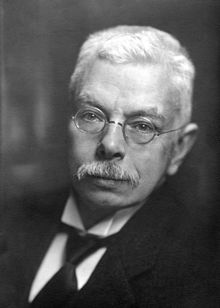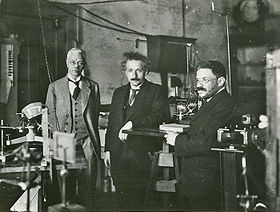Pieter Zeeman
Pieter Zeeman | |
|---|---|
 | |
| Born | 25 May 1865 Zonnemaire, Netherlands |
| Died | 9 October 1943 (aged 78) Amsterdam, Netherlands |
| Nationality | Netherlands |
| Alma mater | University of Leiden |
| Known for | Zeeman effect |
| Awards | Nobel Prize for Physics (1902) Matteucci Medal (1912) Henry Draper Medal (1921) ForMemRS (1921)[1] Rumford Medal (1922) Franklin Medal (1925) |
| Scientific career | |
| Fields | Physics |
| Doctoral advisor | Heike Kamerlingh Onnes |
Pieter Zeeman (25 May 1865 – 9 October 1943) was a Dutch physicist. In 1902, he was awarded the Nobel Prize in Physics together with Hendrik Lorentz for the discovery and theoretical explanation of the Zeeman effect.
Childhood and youth
Pieter Zeeman was born in Zonnemaire, a small town on the island of Schouwen-Duiveland, Netherlands. He was the son of Rev Catharinus Forandinus Zeeman, a minister of the Dutch Reformed Church, and his wife, Willemina Worst.
Pieter was interested in physics at an early age. In 1883, the aurora borealis could be seen in the Netherlands. Zeeman, still a high school student, made a drawing and description of the aurora. He sent it to Nature, where it was published. The editor praised "the careful observations of Professor Zeeman from his observatory in Zonnemaire".
After finishing high school in 1883, Zeeman went to Delft. He studied classical languages, which he needed for admission to University. He stayed with Dr J. W. Lely, co-principal of the gymnasium. Lely was the brother of Cornelis Lely, who was responsible for the idea and building of the Zuiderzee Works. In Delft, he met Heike Kamerlingh Onnes, who was to become his thesis adviser.
Education and early career
Zeeman studied physics at the University of Leiden under Kamerlingh Onnes and Hendrik Lorentz. In 1890, even before finishing his thesis, he became Lorentz's assistant. This allowed him to take part in research on the Kerr effect. In 1893 he submitted his doctoral thesis on the Kerr effect,[2] the reflection of polarized light on a magnetized surface. He then went for six months to Friedrich Kohlrausch's institute in Strasbourg. In 1895, Zeeman came back from Strasbourg to teach mathematics and physics in Leiden. He married Johanna Elisabeth Lebret (1873–1962); they had three daughters and one son.[3][4][5][6]

In 1896, shortly before moving from Leiden to Amsterdam,[8] he measured the splitting of spectral lines by a strong magnetic field. This research looked at what effect magnetic fields would have on a light source. He discovered that the spectral line is split into several parts in the by the magnetic field. Kamerlingh Onnes told Lorentz about Zeeman's observations on Saturday 31 October 1896 at the meeting of the Royal Netherlands Academy of Arts and Sciences in Amsterdam.[9] The next Monday, Lorentz called Zeeman into his office and presented him with an explanation, based on Lorentz's theory of electromagnetic radiation. Zeeman's discovery is now known as the Zeeman effect.
The discovery was important. It proved Lorentz's theory about the polarization of light emitted in the presence of a magnetic field. It showed that the oscillating particles, the source of the light, were negatively charged, and were a thousandfold lighter than the hydrogen atom. This was well before Thomson's discovery of the electron. The Zeeman effect became an important tool for understanding the structure of the atom.
Professor in Amsterdam

Shortly after his discovery, Zeeman was offered a position as lecturer in Amsterdam.[8] In 1900 he became professor of physics at the University of Amsterdam. In 1902, together with Lorentz, he received the Nobel Prize for Physics for the discovery of the Zeeman effect. Five years later, in 1908, he succeeded Van der Waals as full professor and Director of the Physics Institute in Amsterdam.
A new laboratory built in 1923 allowed Zeeman to continue to study the Zeeman effect. The laboratory was renamed the Zeeman Laboratory in 1940. For the remainder of his career he remained interested in research in Magneto-Optics. He also studied the propagation of light in moving media. This became important because of study into special relativity, and enjoyed keen interest from Lorentz and Einstein. Later in his career he became interested in mass spectrometry.
Zeeman died on 9 October 1943 in Amsterdam, and was buried in Haarlem.
References
- ↑ "Fellows of the Royal Society". London: Royal Society. Archived from the original on 2015-03-16.
- ↑ Pieter Zeeman (1893). "Metingen over het verschijnsel van Kerr bij polaire terugkaatsing op ijzer, kobalt en nikkel, in 't bijzonder over Sissingh's magneto-optisch phaseverschil" (PDF).
- ↑ Paul Forman, "Alfred Landé and the anomalous Zeeman Effect, 1919-1921", Historical Studies in the Physical Sciences, Vol. 2, 1970, 153-261.
- ↑ Kox, A. J. (1997). "The discovery of the electron: II. The Zeeman effect" (PDF). European Journal of Physics. 18 (3): 139–144. Bibcode:1997EJPh...18..139K. doi:10.1088/0143-0807/18/3/003. S2CID 53414643.
- ↑ Spencer, J. B. (1970). "On the Varieties of Nineteenth-Century Magneto-Optical Discovery". Isis. 61: 34–51. doi:10.1086/350577. S2CID 145139903.
- ↑ "Pieter Zeeman - Biographical". Nobelprize.org. Nobel Media AB 2013. Retrieved 25 November 2013.
- ↑ "Although not included in the published paper, you may be interested in a picture of Pieter Zeeman, as well as a photo he took of the effect named for him."
- ↑ 8.0 8.1 Dirk van Delft (2007). "Freezing physics" (PDF). p. 260.
- ↑ See:
- Zeeman, P. (1896). "Over de invloed eener magnetisatie op den aard van het door een stof uitgezonden licht" [On the influence of magnetism on the nature of the light emitted by a substance]. Verslagen van de Gewone Vergaderingen der Wis- en Natuurkundige Afdeeling (Koninklijk Akademie van Wetenschappen te Amsterdam) [Reports of the Ordinary Sessions of the Mathematical and Physical Section (Royal Academy of Sciences in Amsterdam)] (in Dutch). 5: 181–184 and 242–248. Bibcode:1896VMKAN...5..181Z.
- Zeeman, P. (1897). "On the influence of magnetism on the nature of the light emitted by a substance". Philosophical Magazine. 5th series. 43: 226–239.